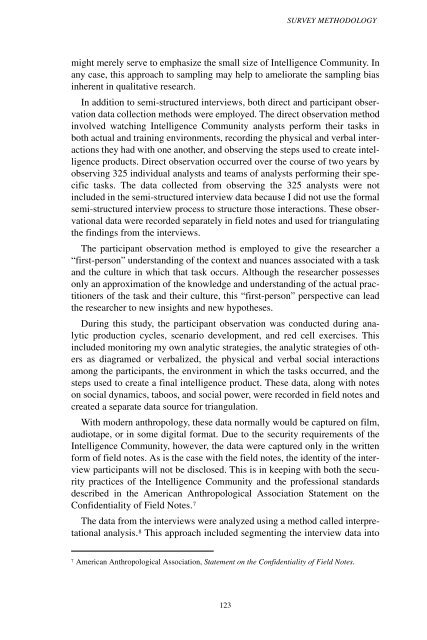Analytic Culture in the U.S. Intelligence Community (PDF) - CIA
Analytic Culture in the U.S. Intelligence Community (PDF) - CIA
Analytic Culture in the U.S. Intelligence Community (PDF) - CIA
You also want an ePaper? Increase the reach of your titles
YUMPU automatically turns print PDFs into web optimized ePapers that Google loves.
SURVEY METHODOLOGY<br />
might merely serve to emphasize <strong>the</strong> small size of <strong>Intelligence</strong> <strong>Community</strong>. In<br />
any case, this approach to sampl<strong>in</strong>g may help to ameliorate <strong>the</strong> sampl<strong>in</strong>g bias<br />
<strong>in</strong>herent <strong>in</strong> qualitative research.<br />
In addition to semi-structured <strong>in</strong>terviews, both direct and participant observation<br />
data collection methods were employed. The direct observation method<br />
<strong>in</strong>volved watch<strong>in</strong>g <strong>Intelligence</strong> <strong>Community</strong> analysts perform <strong>the</strong>ir tasks <strong>in</strong><br />
both actual and tra<strong>in</strong><strong>in</strong>g environments, record<strong>in</strong>g <strong>the</strong> physical and verbal <strong>in</strong>teractions<br />
<strong>the</strong>y had with one ano<strong>the</strong>r, and observ<strong>in</strong>g <strong>the</strong> steps used to create <strong>in</strong>telligence<br />
products. Direct observation occurred over <strong>the</strong> course of two years by<br />
observ<strong>in</strong>g 325 <strong>in</strong>dividual analysts and teams of analysts perform<strong>in</strong>g <strong>the</strong>ir specific<br />
tasks. The data collected from observ<strong>in</strong>g <strong>the</strong> 325 analysts were not<br />
<strong>in</strong>cluded <strong>in</strong> <strong>the</strong> semi-structured <strong>in</strong>terview data because I did not use <strong>the</strong> formal<br />
semi-structured <strong>in</strong>terview process to structure those <strong>in</strong>teractions. These observational<br />
data were recorded separately <strong>in</strong> field notes and used for triangulat<strong>in</strong>g<br />
<strong>the</strong> f<strong>in</strong>d<strong>in</strong>gs from <strong>the</strong> <strong>in</strong>terviews.<br />
The participant observation method is employed to give <strong>the</strong> researcher a<br />
“first-person” understand<strong>in</strong>g of <strong>the</strong> context and nuances associated with a task<br />
and <strong>the</strong> culture <strong>in</strong> which that task occurs. Although <strong>the</strong> researcher possesses<br />
only an approximation of <strong>the</strong> knowledge and understand<strong>in</strong>g of <strong>the</strong> actual practitioners<br />
of <strong>the</strong> task and <strong>the</strong>ir culture, this “first-person” perspective can lead<br />
<strong>the</strong> researcher to new <strong>in</strong>sights and new hypo<strong>the</strong>ses.<br />
Dur<strong>in</strong>g this study, <strong>the</strong> participant observation was conducted dur<strong>in</strong>g analytic<br />
production cycles, scenario development, and red cell exercises. This<br />
<strong>in</strong>cluded monitor<strong>in</strong>g my own analytic strategies, <strong>the</strong> analytic strategies of o<strong>the</strong>rs<br />
as diagramed or verbalized, <strong>the</strong> physical and verbal social <strong>in</strong>teractions<br />
among <strong>the</strong> participants, <strong>the</strong> environment <strong>in</strong> which <strong>the</strong> tasks occurred, and <strong>the</strong><br />
steps used to create a f<strong>in</strong>al <strong>in</strong>telligence product. These data, along with notes<br />
on social dynamics, taboos, and social power, were recorded <strong>in</strong> field notes and<br />
created a separate data source for triangulation.<br />
With modern anthropology, <strong>the</strong>se data normally would be captured on film,<br />
audiotape, or <strong>in</strong> some digital format. Due to <strong>the</strong> security requirements of <strong>the</strong><br />
<strong>Intelligence</strong> <strong>Community</strong>, however, <strong>the</strong> data were captured only <strong>in</strong> <strong>the</strong> written<br />
form of field notes. As is <strong>the</strong> case with <strong>the</strong> field notes, <strong>the</strong> identity of <strong>the</strong> <strong>in</strong>terview<br />
participants will not be disclosed. This is <strong>in</strong> keep<strong>in</strong>g with both <strong>the</strong> security<br />
practices of <strong>the</strong> <strong>Intelligence</strong> <strong>Community</strong> and <strong>the</strong> professional standards<br />
described <strong>in</strong> <strong>the</strong> American Anthropological Association Statement on <strong>the</strong><br />
Confidentiality of Field Notes. 7<br />
The data from <strong>the</strong> <strong>in</strong>terviews were analyzed us<strong>in</strong>g a method called <strong>in</strong>terpretational<br />
analysis. 8 This approach <strong>in</strong>cluded segment<strong>in</strong>g <strong>the</strong> <strong>in</strong>terview data <strong>in</strong>to<br />
7<br />
American Anthropological Association, Statement on <strong>the</strong> Confidentiality of Field Notes.<br />
123
















